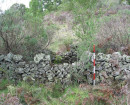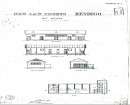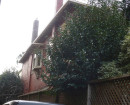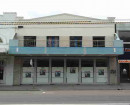LIND HOUSE
450 DANDENONG ROAD CAULFIELD NORTH, GLEN EIRA CITY
-
Add to tour
You must log in to do that.
-
Share
-
Shortlist place
You must log in to do that.
- Download report


















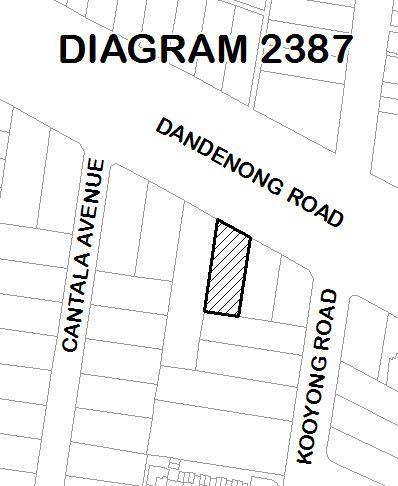

Statement of Significance
What is significant?
How is it significant?
Why is it significant?
-
-
LIND HOUSE - History
Lind House was designed by Russian-born Jewish emigre architect Anatol Kagan, for Polish-Jewish emigre Leo Lind and his wife Dorothy, and was constructed over the period of 1954-55.
Kagan emigrated to Australia in 1939, establishing a successful architectural practice in Melbourne. Kagan specialised in, and became best known for, his designs of large and luxurious residences, particularly in Melbourne's inner-eastern suburbs of Kew, Balwyn and Toorak. Kagan's clientele chiefly consisted of wealthy, self-made emigre businessmen who had also fled Europe in the 1930s and 1940s to seek a new life in Australia.
The house at 450 Dandenong Road, Caulfield North was designed by Kagan for Polish emigre textile manufacturer Leo Lindwaser, who had arrived in Australia in 1947, declaring his occupation as "merchant". Leo Lindwaser and his wife Dorothy established a successful textile business in Melbourne, which later became Lind's Textile Ltd, operating out of Flinders Lane in the 1950s. In 1952, the Lindwasers legally changed their names to Leo and Dorothy Lind.
Ownership of 450 Dandenong Road was transferred to Leo and Dorothy Lind in 1954 and the City of Caulfield Rate Book for 1955-56 records that the house on this site was completed in 1955. The house remained in the Lind family's ownership for nearly four decades, with Leo and Dorothy residing there until their deaths (in 1984 and 1983, respectively), after which time ownership of the house was transferred to their eldest daughter, Margaret. The house was sold to another couple in 1992, who occupied it until 2006, when it again changed ownership. Lind House again changed ownership in 2017 [as of May 2018].
LIND HOUSE - Permit Exemptions
General Exemptions:General exemptions apply to all places and objects included in the Victorian Heritage Register (VHR). General exemptions have been designed to allow everyday activities, maintenance and changes to your property, which don’t harm its cultural heritage significance, to proceed without the need to obtain approvals under the Heritage Act 2017.Places of worship: In some circumstances, you can alter a place of worship to accommodate religious practices without a permit, but you must notify the Executive Director of Heritage Victoria before you start the works or activities at least 20 business days before the works or activities are to commence.Subdivision/consolidation: Permit exemptions exist for some subdivisions and consolidations. If the subdivision or consolidation is in accordance with a planning permit granted under Part 4 of the Planning and Environment Act 1987 and the application for the planning permit was referred to the Executive Director of Heritage Victoria as a determining referral authority, a permit is not required.Specific exemptions may also apply to your registered place or object. If applicable, these are listed below. Specific exemptions are tailored to the conservation and management needs of an individual registered place or object and set out works and activities that are exempt from the requirements of a permit. Specific exemptions prevail if they conflict with general exemptions. Find out more about heritage permit exemptions here.Specific Exemptions:It should be noted that Permit Exemptions can be granted at the time of registration (under s.49(3) of the Heritage Act 2017). Permit Exemptions can also be applied for and granted after registration (under s.92 of the Heritage Act 2017).
General Condition 1
All exempted alterations are to be planned and carried out in a manner which prevents damage to the fabric of the registered place or object.
General Condition 2
Should it become apparent during further inspection or the carrying out of works that original or previously hidden or inaccessible details of the place or object are revealed which relate to the significance of the place or object, then the exemption covering such works shall cease and Heritage Victoria shall be notified as soon as possible.
General Condition 3
All works should ideally be informed by Conservation Management Plans prepared for the place. The Executive Director is not bound by any Conservation Management Plan, and permits still must be obtained for works suggested in any Conservation Management Plan.
General Condition 4
Nothing in this determination prevents the Heritage Council from amending or rescinding all or any of the permit exemptions. 18 28 May 2018
General Condition 5
Nothing in this determination exempts owners or their agents from the responsibility to seek relevant planning or building permits from the relevant responsible authority, where applicable.
SPECIFIC PERMIT EXEMPTIONS
Landscape Exemptions:
. The process of gardening, including mowing, hedge clipping, bedding displays, disease and weed control, and maintenance to care for existing plants. . Subsurface works involving the installation, removal or replacement of watering and drainage systems or services. . Works associated with the management of possums and vermin. . Removal or lopping of trees where there is a risk of personal injury or damage to property. . Removal, or maintenance and repair of existing paving and other hard landscaping elements, like for like. . Removal, or maintenance, repair and replacement of existing fences and gates, like for like.Specific Exemptions:
Building Exteriors
. Repairs and maintenance which replace like with like. . Removal of extraneous items installed after 1955 such as air conditioners, pipework, ducting, wiring, antennae and aerials. . Installation or repair of damp-proofing by either injection method or grouted pocket method. . Painting of previously painted surfaces in the same colour scheme provided that preparation or painting does not remove evidence of the original paint or other decorative scheme.Building Interiors
. Painting of previously painted walls and ceilings provided that preparation or painting does not remove evidence of any original paint or other decorative scheme (no stained timberwork is to be painted). . Removal of paint from originally unpainted or oiled joinery, doors, architraves and skirtings by non-abrasive methods.. Installation, removal or replacement of post-1955 carpets and/or flexible floor coverings.
. Installation, removal or replacement of post-1955 curtain tracks, rods and blinds.
. Installation, removal or replacement of devices for the hanging of wall mounted items.
. Removal and replacement of post-1955 bathroom elements, including sanitary fixtures and associated piping, mirrors, wall and floor coverings.
. Removal of post-1955 tiling in wet areas provided there is no damage to or alteration of original structure or fabric.
. Installation, removal or replacement of electrical wiring provided that all new wiring is fully concealed and any original light switches, push buttons or power outlets are retained in-situ.
LIND HOUSE - Permit Exemption Policy
Preamble
The purpose of the Permit Policy is to assist when considering or making decisions regarding works to a registered place. It is recommended that any proposed works be discussed with an officer of Heritage Victoria prior to making a permit application. Discussing proposed works will assist in answering questions the owner may have and aid any decisions regarding works to the place.
The extent of registration of the Lind House in the Victorian Heritage Register affects the whole place shown on Diagram 2387 including the land, the residence (including the exterior and interiors), street boundary random-coursed stonework walls, other exterior stonework walls, landscape elements and other features.
Under the Heritage Act 2017 a person must not remove or demolish, damage or despoil, develop oralter or excavate, relocate or disturb the position of any part of aregistered place or object without approval. It is acknowledged,however, that alterations and other works may be required to keep placesand objects in good repair and adapt them for use into the future.If a person wishes to undertake works or activities in relation to a registered place or registered object, they must apply to the Executive Director, Heritage Victoria for a permit. The purpose of a permit is to enable appropriate change to a place and to effectively manage adverse impacts on the cultural heritage significance of a place as a consequence of change. If an owner is uncertain whether a heritage permit is required, it is recommended that Heritage Victoria be contacted.
Permits are required for anything which alters the place or object, unless a permit exemption is granted. Permit exemptions usually cover routine maintenance and upkeep issues faced by owners as well as minor works or works to the elements of the place or object that are not significant. They may include appropriate works that are specified in a conservation management plan. Permit exemptions can be granted at the time of registration (under s.49(3) of the Heritage Act 2017) or after registration (under s.92 of the Heritage Act 2017).
It should be noted that the addition of new buildings to the registered place, as well as alterations to the interior and exterior of existing buildings requires a permit, unless a specific permit exemption is granted.
Conservation management plans
It is recommended that a Conservation Management Plan is developed to manage the place in a manner which respects its cultural heritage significance.
Aboriginal cultural heritage
If works are proposed which have the potential to disturb or have an impact on Aboriginal cultural heritage it is necessary to contact Aboriginal Victoria to ascertain any requirements 17 28 May 2018
under the Aboriginal Heritage Act 2006. If any Aboriginal cultural heritage is discovered or exposed at any time it is necessary to immediately contact Aboriginal Victoria to ascertain requirements under the Aboriginal Heritage Act 2006.
Other approvals
Please be aware that approval from other authorities (such as local government) may be required to undertake works.
Archaeology
Ground disturbance may affect any archaeological deposits at the place and, subject to the exemptions stated in this document, requires a permit.
Cultural heritage significance
Overview of significance
The cultural heritage significance of Lind House lies in all of the place at 450 Dandenong Road, including the exterior and interiors of the residence; the low street boundary random-coursed stonework wall and other stonework walls; front and rear undercroft areas; rear concrete staircase and navy-blue painted steel pipe columns and balustrading; landscape elements including paving, stonework steps, and letterbox; and fixtures attached to the building including, but not limited to, wall panelling, ceiling linings, doors, parquetry floors, in-built upholstery, light fittings, vent grates, intercom system, and in-built furniture, cupboards, cabinets and shelves. The first floor bathroom and kitchen were refurbished in the 1980-1990s, and introduced elements of these spaces are considered to be of non-contributory cultural heritage significance.
-
-
-
-
-
MYOORA
 Victorian Heritage Register H0490
Victorian Heritage Register H0490 -
ANSELM
 Victorian Heritage Register H1795
Victorian Heritage Register H1795 -
TRAM SHELTER
 Victorian Heritage Register H0230
Victorian Heritage Register H0230
-
"AQUA PROFONDA" SIGN, FITZROY POOL
 Victorian Heritage Register H1687
Victorian Heritage Register H1687 -
'Aqua Profonda' sign wall sign, Fitzroy Swimming Pool
 Yarra City H1687
Yarra City H1687 -
1 Campbell Street
 Yarra City
Yarra City
-
-






